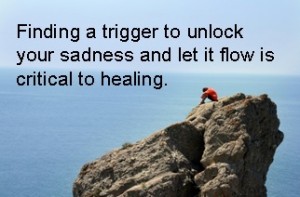Sadness occurs when we lose something we want and value. In our society, we tend to try to stop people from crying, instead of encouraging them to continue and helping them to explore the depths of their feelings.
Most people put a lot of effort into shaking sadness, but it has its advantages. It enforces a reflective retreat and leaves us in a suspended state to mourn our loss and then make adjustments and new plans that will allow us to move forward. However, we need to be careful that sadness does not turn into depression – the same feeling without the adjusting and planning for the future. Sadness is useful, however depression is not, and should be addressed with the help of a professional.
Expressing sadness is a critical part of the grieving process. This emotion may need to be released regularly and in large quantities for a period of time until the sadness reaches a level that is manageable and allows us to move forward. Simply watching sad movies is usually enough to get us started and make a dent in the sadness ‘storage facility’. The movie itself isn’t important – it’s just a trigger to evoke the sadness, and you may find another type of trigger works better for you. The important thing is to find your trigger, use it, and then let the tears come.
Sadness may never leave completely – in fact it’s highly likely it won’t. With any significant loss there will always be a sense of sadness as we remember what we have lost.
Given that sadness usually sits underneath anger, it is critical that we address any feelings of anger first so that we can connect fully with our sadness.
We experience sadness in our chest area, specifically in our hearts. We can all relate to the feeling of our hearts aching with the thought of our loss. Sadness can also show up as constricted sensations in the chest, a dull heavy or numb feeling in the chest, pain along the breastbone, difficulty getting out of bed in the morning, congested sinuses and chest along with thoughts that dwell on the negative. As we revisit our experience we can become more aware of where we are experiencing the feeling in our body. This serves to confirm whether the emotion is likely to be sadness.
Sadness, like anger, needs to be expressed fully, openly and wholeheartedly so that it doesn’t creep up on us unexpectedly.
Until next time
Helen


